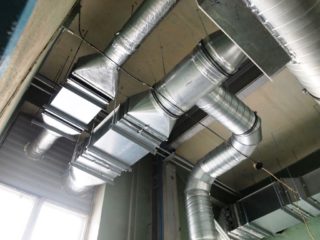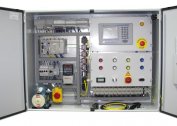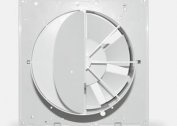Today, a person spends a significant part of his life indoors. If you believe scientific research on this topic, then for urban residents this time is about 75%. At the same time, for the normal functioning of the human body, at least 20 thousand liters of air are required daily. To meet this need, and at the same time to solve issues related to the cleanliness, temperature and humidity level of the air in the room, heating and ventilation are used - specialized systems installed inside buildings and structures.
The main tasks of ventilation
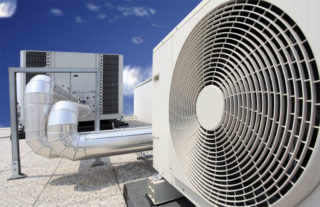 Modern ventilation systems must perform the following tasks:
Modern ventilation systems must perform the following tasks:
- maintaining the optimal level of oxygen content in the room;
- air purification from substances hazardous to human health;
- removal of excess moisture from structural elements of buildings and houses;
- ensuring a certain temperature and humidity regime;
- reduction in operating costs for the maintenance of houses and structures;
- ensuring sound insulation in the house, due to the absence of the need for ventilation with windows and doors.
Project development and installation work of the ventilation system
The above list of tasks is used to determine the requirements that the designed ventilation systems must meet, after which, in fact, the process of creating them begins. In this case, the project should contain a description of all aspects of the operation of ventilation and air conditioning.
In turn, the installation of such systems includes several stages:
- manufacturing and transportation of installed equipment;
- installation;
- commissioning with adjustable parameters;
- operational and service maintenance.
The importance of a professional approach to the operation and maintenance of the ventilation system
It is clear that ventilation should work both efficiently and continuously. This requires timely and complete maintenance and repair of equipment. It is important that such work is carried out only by those who have not only qualifications, but also significant experience in this field.
Our company offers the widest range of services related to the equipment of ventilation and air conditioning systems, both in individual rooms and in the entire building, including residential buildings of small and large floors. Experienced staff, the availability of modern materials and related equipment allows us to perform each of the above steps in strict accordance with regulatory and technical requirements.
Natural ventilation
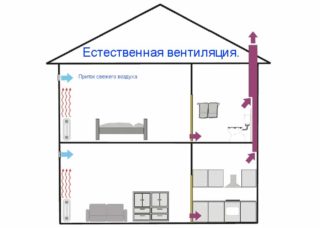 The ventilation installed today in buildings and separate rooms and houses can be of two types - natural and artificial. The first option involves a complete rejection of electrical equipment. Fresh air supply is organized due to natural environmental factors - wind, temperature and atmospheric pressure. The main advantage of such systems is the simplicity of design and the reliability and durability due to the lack of sophisticated electrical equipment, as well as low cost. Along with dignity, they have a number of shortcomings, caused primarily by the principle of action. We are talking about a strong dependence on the characteristics of the external environment, which are constantly changing, and in addition, the lack of the ability to regulate the operation of such systems. For these reasons, natural ventilation is best suited for indoor use.
The ventilation installed today in buildings and separate rooms and houses can be of two types - natural and artificial. The first option involves a complete rejection of electrical equipment. Fresh air supply is organized due to natural environmental factors - wind, temperature and atmospheric pressure. The main advantage of such systems is the simplicity of design and the reliability and durability due to the lack of sophisticated electrical equipment, as well as low cost. Along with dignity, they have a number of shortcomings, caused primarily by the principle of action. We are talking about a strong dependence on the characteristics of the external environment, which are constantly changing, and in addition, the lack of the ability to regulate the operation of such systems. For these reasons, natural ventilation is best suited for indoor use.
Artificial ventilation
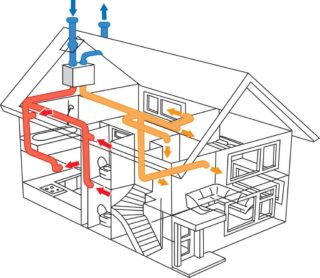 It is characterized by the presence of a whole complex of equipment that allows you to remove the dependence on the external environment or to solve the problem of the inaccessibility of fresh air, or to ensure compliance with its specific requirements. Such systems are of two types - supply and exhaust. The first option involves the supply of fresh air to the premises. In this case, the air mass along the way into it can be subjected to additional processing - cleaning, heating or cooling. In addition, the supply ventilation can ensure its supply to certain areas of the room. In turn, exhaust ventilation ensures the removal of air from buildings and premises that does not meet certain requirements (temperature, humidity and the content of foreign particles). As a rule, in homes, exhaust systems work in a single "bundle" with the supply. At the same time, their productivity should be approximately equal, so that the atmospheric pressure inside corresponds to similar indicators in the external environment.
It is characterized by the presence of a whole complex of equipment that allows you to remove the dependence on the external environment or to solve the problem of the inaccessibility of fresh air, or to ensure compliance with its specific requirements. Such systems are of two types - supply and exhaust. The first option involves the supply of fresh air to the premises. In this case, the air mass along the way into it can be subjected to additional processing - cleaning, heating or cooling. In addition, the supply ventilation can ensure its supply to certain areas of the room. In turn, exhaust ventilation ensures the removal of air from buildings and premises that does not meet certain requirements (temperature, humidity and the content of foreign particles). As a rule, in homes, exhaust systems work in a single "bundle" with the supply. At the same time, their productivity should be approximately equal, so that the atmospheric pressure inside corresponds to similar indicators in the external environment.
Local and general ventilation
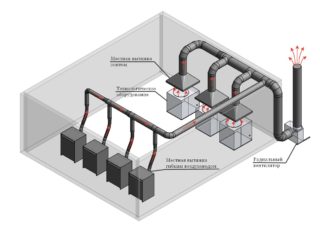 In the first case, it is used to organize the supply of fresh air to certain areas of the room, or, conversely, for its removal. Such systems demonstrate the greatest efficiency at manufacturing enterprises. In turn, general ventilation is used mainly in residential buildings, and it can also be supply and exhaust. In addition, there are typesetting and monoblock systems. Typesetting ventilation is a complex of equipment composed of various mechanisms, ranging from fans to automated control systems. They are placed in two ways - over suspended ceiling structures or separate rooms are allocated for them. Due to this, typesetting ventilation is widely used. As a rule, these are separate houses.
In the first case, it is used to organize the supply of fresh air to certain areas of the room, or, conversely, for its removal. Such systems demonstrate the greatest efficiency at manufacturing enterprises. In turn, general ventilation is used mainly in residential buildings, and it can also be supply and exhaust. In addition, there are typesetting and monoblock systems. Typesetting ventilation is a complex of equipment composed of various mechanisms, ranging from fans to automated control systems. They are placed in two ways - over suspended ceiling structures or separate rooms are allocated for them. Due to this, typesetting ventilation is widely used. As a rule, these are separate houses.
In turn, monoblock ventilation is perfect only for individual rooms. All components of such systems are located inside a soundproof enclosure. Another advantage is the lack of commissioning. They are carried out in the production process. In addition, one can not fail to note another important fact, namely, monoblock ventilation compared to its type-setting analogue is much cheaper.
It should be noted that for residential buildings and industrial premises, ventilation systems are very important. Constant air circulation allows not only to ensure the comfort of being inside. It is about health, which largely depends on the quality of the inhaled air, which should be not only fresh, but also clean. In a residential building, this will ensure a good rest, and in the office building and at an industrial enterprise it will significantly increase labor productivity.
